U.S. Department of Transportation
Federal Highway Administration
1200 New Jersey Avenue, SE
Washington, DC 20590
202-366-4000
Federal Highway Administration Research and Technology
Coordinating, Developing, and Delivering Highway Transportation Innovations
|
R&T NOW This newsletter is an archived publication and may contain dated technical, contact, and link information. |
|
| Publication Number: Date: March/April 2019 |
Publication Date: March/April 2019
|
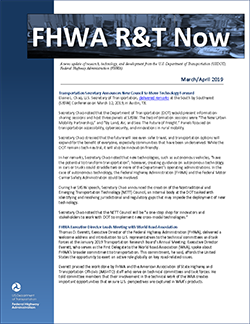
PDF files can be viewed with the Acrobat® Reader®
In this issue…
Elaine L. Chao, U.S. Secretary of Transportation, delivered remarks at the South by Southwest (SXSW) Conference on March 12, 2019, in Austin, TX.
Secretary Chao noted that the Department of Transportation (DOT) would present information-sharing sessions and host three panels at SXSW. The two information sessions were "The New Urban Mobility Partnership," and "By Land, Air, and Sea: The Future of Freight." Panels focused on transportation accessibility, cybersecurity, and innovations in rural mobility.
Secretary Chao stressed that the future will see even safer travel, and transportation options will expand for the benefit of everyone, especially communities that have been underserved. While the DOT remains tech-neutral, it will also be innovation-friendly.
In her remarks, Secretary Chao noted that new technologies, such as autonomous vehicles, "have the potential to transform transportation"; however, creating guidance on autonomous technology in cars or trucks could straddle two or more of the Department’s operating administrations. In the case of autonomous technology, the Federal Highway Administration (FHWA) and the Federal Motor Carrier Safety Administration could be involved.
During her SXSW speech, Secretary Chao announced the creation of the Nontraditional and Emerging Transportation Technology (NETT) Council, an internal body at the DOT tasked with identifying and resolving jurisdictional and regulatory gaps that may impede the deployment of new technology.
Secretary Chao noted that the NETT Council will be "a one-stop shop for innovators and stakeholders to work with DOT to implement new cross-modal technologies."
Thomas D. Everett, Executive Director of the Federal Highway Administration (FHWA), delivered a welcome address and introduction to U.S. representatives to the technical committees and task forces at the January 2019 Transportation Research Board’s Annual Meeting. Executive Director Everett, who serves as the First Delegate to the World Road Association (WRA), spoke about FHWA’s broader commitment to transportation. This commitment, he said, affords the United States the opportunity to exert an active role globally on key road-related issues.
Everett praised the work done by FHWA and the American Association of State Highway and Transportation Officials (AASHTO) staff who serve on technical committees and task forces. He told committee members that their involvement in the technical work of the WRA creates important opportunities that ensure U.S. perspectives are captured in WRA’s products.
The products--reports, guidelines, webinars, fact sheets, and other information tools--are useful for the worldwide professional roads community.
While noting the important work of committee members and organizations in the final products of the committees and task forces, Everett also encouraged members to increase the distribution of the products and to seek ways to help distribute the products to the U.S. transportation community.
For more information, contact Agnes Vélez, 202–366–5771, Agnes.Velez@dot.gov.
Dr. Jennifer Nicks, a geotechnical research engineer at FHWA’s Turner-Fairbank Highway Research Center (TFHRC), is leading the multiyear Bearing Resistance of Large Diameter Open-End Piles (LDOEPs) project, which aims to calibrate resistance factors for pipe piles that are 30 inches in diameter or larger. Piles can be manufactured from wood, concrete, or steel, and are driven into the soil until a hard stratum is reached, which provides stability for the pile.
Nicks notes that the American Association of State Highway and Transportation Officials Load and Resistance Factor Design (LRFD) Bridge Design Specifications "provide resistance factors for commonly used static and dynamic analysis methods to estimate bearing resistance, but the calibrations are based on load tests for open-end piles that are less than 24 inches in diameter." With the increasing use of LDOEPs, Nicks continued, "the reliability of those resistance factors was unknown on piles greater than 30 inches." Large diameter open-end piles are often preferred by the industry over similar-sized drilled shafts and/or pile groups because they provide a cost-effective solution and address constructability and environmental concerns. Large open-end piles are also a good solution for supporting larger lateral, seismic, and axial loads. The final report detailing the study and providing design recommendations is expected later in 2019.
As part of the initial stages of this project, the FHWA Deep Foundation Load Test Database (DFLTD v.2) was revamped for functionality with current operating system environments. An additional 150 LDOEP load tests were added to the database. Researchers, professors, students, consultants, and contractors from around the world have downloaded DFLTD v.2 more than 350 times to date. The database is useful for preliminary design assumptions, other research efforts, and LRFD calibrations.
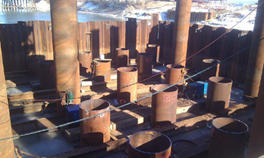
Source: FHWA
A group of 42-inch diameter, spiral weld, open-end pipe piles for a main bridge pier support.(1)
Nicks brings a wealth of knowledge and experience to her research at TFHRC, where she has been since March 2010. She serves as Chair of the Transportation Research Board’s (TRB’s) Geosynthetics Committee, Vice-Chair of the Geo-Institute (G-I) of the American Society of Civil Engineer’s Geotechnics of Soil Erosion Committee, and is a member of various councils and committees, including TRB’s Hydraulics and Hydrology Committee, the G-I’s International Activities Council, Deep Foundations Institute’s Driven Pile and Women in Deep Foundations Committees, and the International Society for Soil Mechanics and Geotechnical Engineering’s Innovation and Development Committee.
Nicks holds a Bachelor’s of Science degree in Civil Engineering (Structures), a Masters in Engineering, and a Ph.D. in Civil Engineering (Geotechnical), all from Texas A&M University.
For more information on the Bearing Resistance of LDOEPs project, contact Jennifer Nicks, 202–493–3075, Jennifer.Nicks@dot.gov.
1 Hannigan, PE, Patrick J., Rausche, PhD, PE, Frank, Likins, PE, Garland E., et al. (2016). Design and Construction of Driven Pile Foundations - Volume I, Report No. FHWA-NHI-16-009, FHWA, Washington, DC.
The Long-Term Bridge Performance (LTBP) Program released the LTBP InfoBridge™ Web portal at the Transportation Research Board’s Annual Meeting in January 2019. The portal is a user-friendly Web application that includes intuitive tools for finding, viewing, and analyzing bridge performance information. It provides for storage, retrieval, dissemination, analysis, and visualization of data collected through State, national, and LTBP Program efforts. These capabilities will provide users with the ability to assess bridge performance on a network of bridges or on individual bridges.
The Web portal also gives users the ability to share data selections and summary reports efficiently. The FHWA’s goal is to make LTBP InfoBridge™ a comprehensive resource that will enable researchers to develop tools and products that will enhance the understanding of the performance of highway bridge assets, leading to more efficient design, construction, rehabilitation, maintenance, preservation, and management of bridges.
Since the InfoBridge release, LTBP Program staff have conducted two webinars to demonstrate the capabilities of the portal. One webinar was for internal FHWA Division and Program offices and the second webinar was for external FHWA partners.
The LTBP Program is an FHWA long-term research effort to help the bridge community better understand bridge performance. The overall objectives of the Program are to monitor representative samples of bridges nationwide to collect, document, maintain, manage, and disseminate high-quality quantitative performance data over an extended time horizon. The LTBP Program is designed to collect critical performance data that are not available elsewhere and merge them with data gathered from available sources.
For more information, contact Jean Nehme, 202–493–3042, Jean.Nehme@dot.gov.
Dr. Benjamin Graybeal, Team Leader for Bridge Engineering Research, represented the FHWA at the February 28 meeting of the American Association of State Highway and Transportation Officials (AASHTO) Bridges and Structures Technical Committee on Concrete Design. Graybeal delivered a 90-minute invited lecture on emerging use of ultra-high performance concrete (UHPC), with a specific focus on UHPC structural design guidelines that FHWA is developing for AASHTO. There is growing interest in using UHPC for primary structural elements in bridges. Owners and designers currently lack consensus guidance for this application; this AASHTO committee seeks to remedy the situation by engaging FHWA’s deep well of knowledge in the technology.
The AASHTO Technical Committee on Concrete Design is charged with maintaining the AASHTO LRFD provisions related to structural concrete. They formally convene meetings four times a year. Reggie Holt, HIBS, serves as the official FHWA liaison to the committee. Ben Graybeal, HRDI, serves as an invited technical expert. This most recent meeting was held in conjunction with the Precast/Prestressed Concrete Institute meetings that were concurrently occurring in Louisville, KY.
For more information, contact Benjamin Graybeal, 202–493–3122, Benjamin.Graybeal@dot.gov.
As part of the bilateral cooperation between FHWA and Japan, FHWA staff from the Offices of Infrastructure Research and Development, International Programs, and Infrastructure hosted representatives from Japan’s National Institute for Land and Infrastructure Management (NILIM) at FHWA’s Turner-Fairbank Highway Research Center on March 21 and 22, 2019.
The meeting resulted in an information exchange and discussion on research and development related to bridges and structures in both countries. The focus was on four areas of mutual interest with potential collaboration opportunities:
The United States and Japan have a long and successful history of cooperation. Since 1984, the two countries have held bridge engineering workshops and technical exchanges, bringing together engineers and researchers for technical discussions on various bridge issues, such as earthquake protection, reduction of wind damage, bridge management, and high-performance materials. Most recently, on July 16–17, 2018, FHWA with the California Department of Transportation hosted the 31st U.S.-Japan Bridge Engineering Workshop focusing on "innovative bridge design and preservation." These exchanges have proven an effective means of improving bridge technology, safety, and best practices in both countries. Additionally, cooperative activities have included joint postevent reconnaissance, especially after major earthquakes.
The next U.S.-Japan Workshop will be in Japan in 2020.
For more information, contact Sheila Duwadi, 202–493–3106, Sheila.Duwadi@dot.gov.
A recently published FHWA report examines the movement of superheavy loads (SHLs) on the Nation’s highways. SHLs are much larger and heavier than the materials that standard trucks haul. Gross vehicle weights of SHLs can often exceed several million pounds and require specialized trailers for transporting the material. Additionally, the pavements on which SHLs will travel must be examined to ensure they are structurally adequate to accommodate the SHL.
To support this research, FHWA’s Nadarajah Sivaneswaran will moderate a Transportation Research Board webinar on Tuesday, April 23, 2019. The webinar will examine procedures for analyzing the impacts of moving SHLs on flexible pavements. The procedures are detailed in a 10-volume series of reports, consisting of a final report and 9 appendices. The webinar will also review the Superheavy Load Pavement Analysis Package (SuperPACK) software, a program developed to evaluate specific cases of SHL-vehicle movements. Volume X - Appendix I describes the major components of SuperPACK: preanalysis modules, analysis modules, and an analysis engine.
For more information, contact Nadarajah Sivaneswaran, 202–493–3147, Nadarajah.Sivaneswaran@dot.gov.
In January 2019, FHWA welcomed five new National Research Council (NRC) research associates to the Agency. Through the Exploratory Advanced Research (EAR) Program, FHWA participates in the NRC Research Associateship Program (RAP) by inviting postdoctoral researchers with appropriate backgrounds to investigate specific problems on a short-term basis across a wide range of topics and disciplines.
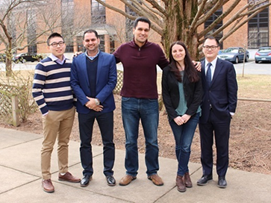
Source: FHWA
The research associates are (from left): Heng Liu, Mohammad Goli, Sattar Dorafshan, Milena Rangelov, and Zhou Yang.
The new associates and their research projects are:
More information about the RAP can be found here or by contacting Jim Shurbutt at 202–493–3420, Jim.Shurbutt@dot.gov.
The EAR Program’s Research Associates Program 2018 booklet contains summary descriptions of some of the recent projects that current and former NRC associates have investigated during their tenure at FHWA.
The FHWA’s Exploratory Advanced Research (EAR) Program published the EAR Program Research Results catalog, which was updated to include summary descriptions of research results through 2018. The catalog’s publication marks the 10th anniversary of the EAR Program providing research results. The EAR Program addresses longer term, higher risk breakthrough research with the potential for long-term improvements to transportation systems.
The results of EAR Program-funded projects may include new fundamental insights about how they can be applied in highway transportation. These projects may lead to new research methods, models, or data that can accelerate applied research or to new system concepts or prototypes, including laboratory testing and, possibly, limited field testing. The EAR Program does not fund projects through commercialization or deployment. Rather, results must be taken up by the research community, with the support of other funding sources. FHWA is committed to transitioning the results of EAR Program-funded projects and takes an active role in demonstrating results to audiences critical to continuing the research and development cycle.
Through 11 solicitations, the EAR Program has awarded 88 projects (19 of which are ongoing) involving both Government and academic researchers. These projects represent the investment of $88 million in FHWA funds and leverage $28 million in matching funds.
More information about the EAR Program is available on its website.
On March 5, 2019, the White House Office of Science and Technology Policy released a report titled Emerging Technologies to Support an Aging Population. The report identifies six areas in which emerging technologies can assist aging Americans and provides recommendations for continued research and development to meet those needs. The six areas are key activities of daily living; cognition; communication and social connectivity; personal mobility; transportation; and access to healthcare.
According to the transportation section of the report, "Movement around and beyond the community is key for individuals to be able to access social, health, and business facilities." The transportation section addresses various stages of the aging process from the driving skills of older adults to examining new technologies that could help older adults use public transportation more safely and easily.
In addition to being a member of the Task Force on Research and Development for Technology to Support Aging Adults, Mohammed Yousuf at FHWA’s TFHRC coauthored the section on transportation.
For more information on this initiative, contact Mohammed Yousuf, Program Manager for the Accessible Transportation Technology Research Initiative, 202–493–3199, Mohammed.Yousuf@dot.gov.
The first Moving Innovation from Research to Implementation Boot Camp was held at TFHRC on February 21. The boot camp focused on how researchers can communicate their projects and achievements to nonresearchers, and was designed to be interactive. The session fostered active participation by encouraging researchers to ask questions and share best practices and success stories. The boot camp included exercises in developing elevator pitches and conducting market research.
Success stories shared by the researchers included effectively implementing Ultra-High Performance Concrete material, building support for the Evaluation of Low Cost Safety Improvements project, and creating an ecosystem for Cooperative Automation Research Mobility Applications (CARMA). The boot camp also included a session on the Technology Readiness Level tool and an overview of FHWA resources designed to help transfer technologies and programs within FHWA.
A second boot camp is scheduled for May 13 at TFHRC.
For more information, contact Mary Huie, 202–493–3460, Mary.Huie@dot.gov.
The Human Factors (HF) team at FHWA’s TFHRC launched research on a bicycle collision avoidance system. The study is being conducted in TFHRC’s Virtual Reality Laboratory (VRL) on a bicycle simulator, and will evaluate different hazard alerts to inform a bicyclist of possible threats. The VRL at TFHRC began operation in the spring of 2016.
Two alerts tested include a visual alert, received through a mounted virtual cell phone displaying the direction of the hazard, and a haptic alert (vibrations received in the bike’s handlebars).
The bicycle collision research is the first VRL study to use a bicycle and is a component of vehicle-to-bicyclist communication.
The research conducted in the lab will use virtual reality (VR) technology to investigate safety issues relevant to pedestrians and bicyclists in a safe, controlled environment.
Using VR in a simulated environment has been employed as a testing tool in many contexts and disciplines.
A crash involving pedestrians, bicyclists, and motor vehicles could result in serious injury and even death; consequently, researchers have focused efforts to investigate these safety issues in the customized environment of immersive VR. Like other forms of simulated environments, VR has the advantage of providing a safe environment in which researchers can learn from mistakes that might otherwise cause injury in the real world. For example, VR has often been used to teach safe crossing behaviors to both adults and children. Additionally, VR environments can be changed based on the goals of the study. For example, in the VR environment, the researcher can change the weather from a clear, sunny day to a snowy day with slick roads by simply pressing a button.
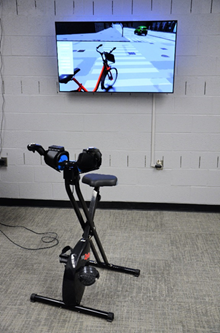
Source: FHWA
The bicycle simulator in TFHRC’s VR laboratory. The bike is positioned in front of a television screen, which shows the simulation that a user would see when using the VR headset.
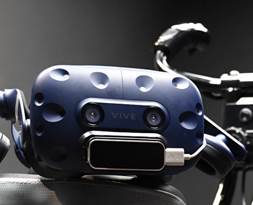
Source: FHWA
The virtual reality headset.
In addition to conducting the bicycle study in the VRL, members of the HF team attended the April 2019 MassDOT Transportation Innovation Conference, the largest conference of its kind in Massachusetts. The HF team demonstrated the bicycle simulator as part of an interactive demonstration of the latest transportation technologies.
For more information, contact Brian Philips, Ph.D., Human Factors Team Leader, 202–493–3468, Brian.Philips@dot.gov.
This issue includes: Setting a Course to Interoperability; A Conversation With Frederick "Bud" Wright; Are Your Roads Weather Savvy?; Measuring Maturity; Making Connections
The issue is available online.
For more information, contact Lisa Shuler, Lisa.A.Shuler@dot.gov
The issue includes the following articles: Virtual Public Involvement: Using Today’s Technology to Engage Transportation Stakeholders More Effectively; Project Bundling; Agencies Streamline Environmental and Permitting Reviews to Delivers Projects Faster; Success Stories: Every Day Counts Advances FHWA Strategic Plan; Rhode Island Goes Digital for Interchange Project; States Innovate!; Explore How States Innovate
The issue is available online.
Please forward this newsletter to others you think might find it interesting and/or useful.
Suggestions may be submitted to FHWA_Now@fhwa.dot.gov.
FHWA R&T Now is a newsletter containing information and updates about research, technology, and development from the U.S. Department of Transportation, Federal Highway Administration. The newsletter is an electronic newsletter and is updated approximately every other month.
Send your comments, questions, and feedback to FHWA_Now@dot.gov.
Online access:
https://www.fhwa.dot.gov/publications/rtnow/.
Mail:
Federal Highway Administration
FHWA Office of Research, Development, and Technology
Attention: R&T Now Managing Editor
6300 Georgetown Pike
McLean, VA 22101
Distribution–FHWA R&T Now is being distributed according to a standard distribution. Direct distribution is being made to the FHWA Divisions and Resource Center
Key Words–LTPP, UHPC, concrete, virtual reality, pavement performance, large diameter open-end piles, bridges, superheavy loads, flexible pavement, bicycle, simulators.
Notice–This document is disseminated under the sponsorship of the U.S. Department of Transportation in the interest of information exchange. The U.S. Government assumes no liability for the use of the information contained in this document. The U.S. Government does not endorse products or manufacturers. Trademarks or manufacturers' names appear in this document only because they are considered essential to the objective of the document.